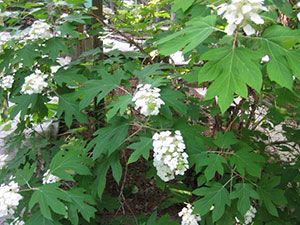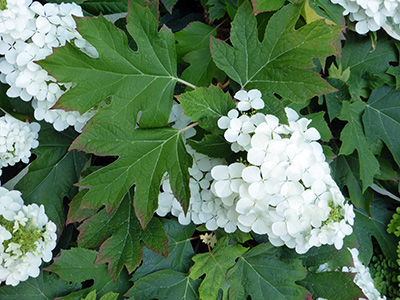Oakleaf Hydrangea
Looking for a native plant that thrives in the shade? Look no further than oakleaf hydrangea.
Characteristics
Oakleaf hydrangea is a coarse-textured native shrub that works well as an understory planting under larger trees like live oaks.
Each summer, oakleaf hydrangea puts up huge cone-shaped clusters of white flowers that will stay on the plant for months, eventually changing to a light pink or purple. Several cultivars are available that offer superior flowers.
The broad, dark green leaves are oak-shaped, giving the plant its name. They make an attractive backdrop for other plants. The leaves are largest on plants grown in the shade, reaching up to 8 to 12 inches long and almost as wide. They turn red, bronze or purple in the fall and may stay on the plant well into winter, though ultimately the plant is deciduous.
Even when its stems are bare, oakleaf hydrangea still adds interest to the landscape thanks to the interesting bark that peels back along its stems.
These large shrubs can reach 6 to 10 feet tall and have an even wider spread. Dwarf forms are also available.
Known scientifically as Hydrangea quercifolia, oakleaf hydrangea is suited to USDA plant hardiness zones 5-9a.
Planting and Care

Oakleaf hydrangea will perform best if planted in a fertile, well-drained soil, but it will also tolerate other conditions. Pick a spot that has partial to almost full shade. In some climates oakleaf hydrangea can be grown in full sun, but in Florida it needs at least some shade.
The plant can be somewhat sprawling and is known to send up new shoots, so be sure to leave it plenty of room to grow. If you have limited space, try one of the more compact cultivars like ‘Pee Wee’.
Follow UF/IFAS guidelines for planting shrubs, and provide water until the plant is established. After that it should require little irrigation or other maintenance, aside from watering during extended dry periods or pruning occasionally to maintain form.
For more information on oakleaf hydrangea, contact your county Extension office.

